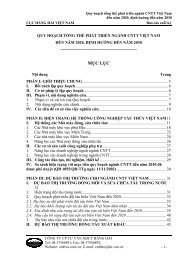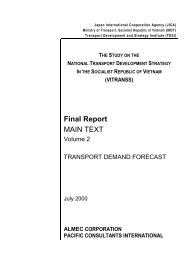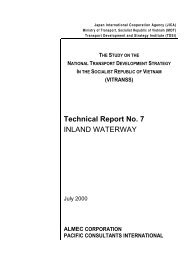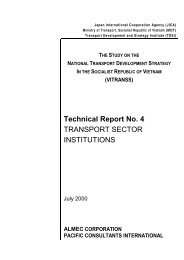Technical Report No. 8 PORT AND SHIPPING
Technical Report No. 8 PORT AND SHIPPING
Technical Report No. 8 PORT AND SHIPPING
Create successful ePaper yourself
Turn your PDF publications into a flip-book with our unique Google optimized e-Paper software.
I-5-3<br />
Vietnam National Transport Strategy Study (VITRANSS)<br />
<strong>Technical</strong> <strong>Report</strong> <strong>No</strong>. 8<br />
Shipping and Ports<br />
accurate estimation of the required containerization, since, at present, almost all<br />
general cargoes are being containerized for safety and efficiency. Despite the impact<br />
of the economic crisis on Asian economies, container traffic to and from other parts<br />
of Asia will increase more rapidly than the world average. It was also reported that the<br />
most rapid container traffic increase is expected in west and south Asia, where<br />
container revolution is still in its infancy. This gives Vietnam a great potential to<br />
increase its container traffic in the coming years. In fact, Vietnam has handled a total<br />
of 820,190 TEU container cargoes in 1998, with an average growth rate of 37% from<br />
1991 to 1998. In the past three years alone, it has recorded an average of 15%<br />
growth rate a year. Based on a comprehensive study and survey of demand patterns<br />
by the VITRANSS Study Team for the long-term strategy (2020) and the mediumterm<br />
Master Plan (2010), the projected containerization is as follows:<br />
Domestic Shipping<br />
Table 5.2.1<br />
Projected Containerization in Vietnam<br />
Year High Assumption<br />
2010 3,404,000 TEU<br />
2020 7,004,000 TEU<br />
There is no distinct service jurisdiction between major state-owned shipping lines<br />
and the private sector. This makes the authorized state-owned shipping lines<br />
enjoy the dominant share in the transport of domestic cargoes on their oceangoing<br />
vessels. It may be an acceptable arrangement for the meantime to protect<br />
its own flag vessels. But in the coming years, opportunities for major<br />
consignments should be given to both state-owned and private operators, thus<br />
liberalizing the shipping industry to encourage its continuous development and<br />
upgrading of services.<br />
Domestic shipping services will be upgraded through the (1) assignment of<br />
medium-size vessels (3,000-5,000 DWT), (2) promotion of containerization and<br />
specialization; and (3) provision of economical and reliable operations with good<br />
intermodal connection.<br />
Ship Finance<br />
Except for some dominant state shipping and JV companies with foreign carriers,<br />
almost all shipping operators have difficulty securing financial loans to fund their<br />
fleet expansion plans. The Ministry of Finance (MOF) is planning to establish a<br />
State Financial Investment Company (SFICO) and is submitting its project<br />
proposal to government. The SFCIO is expected to be an intermediary financial<br />
body between government and shipping companies and will be authorized to<br />
carry out direct investments, at the same time it will be responsible to<br />
government for capital investments in the industry.












